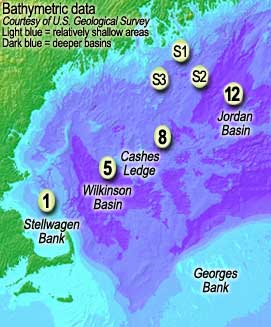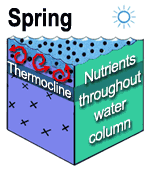
Common Gulf of Maine bloom species are diatom chains & colonies and Phaeocystis.
Was spring in bloom during our April cruise? Investigate data from Stations 1 | 5 | 8 | 12 | S1 | S2 | S3 (<<<).
Examine temperature and salinity profiles: which stations, if any, had layered condtions?
Look at the fluorescence profiles and the diversity of surface plankton for each station. You may also wish to look at regional chlorophyll data.
|
FlowCAM
phyto images from deep water are available for Stations 5, 8
& 12 (>>>). Do deep plankton look similar to those from
surface waters?
|
|||
Consider the traditional "textbook" view of spring conditions in ocean waters (>>>):
"In spring, increased sunlight leads to the formation of thermocline. Winds stir the nutrient-rich upper waters without sending phytoplankton below the thermocline / sunlit zone."
According to this scenario, phytos found below the thermocline are neither growing or reproducing. Do images from deep waters at Stations 5, 8 & 12 support this? How might phytos that are not growing or reproducing contribute to the ecosystem? (Dr. Mike has hints.)
 |
 |
Some of the seven stations were in spring bloom during our April cruise. Did these stations have something in common in terms of location and / or depth? (See bathymetry image.) Did they have layered conditions?
Stations 5, 8 & 12 had high fluorescence at depth. What types of phytos were sampled at depth? Any typical "spring bloom" species? If so, where did these "spring bloomers" come from?
Does your research support the "textbook view" of spring (above)?